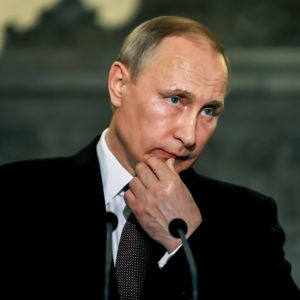Russian President Vladimir Putin has a 20-year history of exploiting foreign lands to overcompensate for his domestic shortcomings.
Make no mistake: Russia’s threat to Ukraine’s sovereignty is real and deserves an international response. However, this moment is not novel–e.g., the ’08 Russo-Georgian war and the ‘14 annexation of Crimea. Putin’s revanchism isn’t going anywhere soon. Instead, unprovoked aggression is a part of Putin’s autocratic playbook to distract the Russian people from their domestic problems.
Prominent among many festering domestic issues, Putin has a series of interrelated population-based problems. While Russia reversed its multi-decade population decline during the 2010s, its current fertility rate of 1.6 children per woman sits below 2.1, which is needed to increase its population annually. At the other end of the age spectrum, Russia’s greying population diminishes the country’s economic productivity and strains government services. Tragically, Putin’s confused COVID response also contributed to Russia’s largest-ever peacetime population decline in 2020.
Like many nations with declining fertility rates and aging populations, Putin made increased immigration a central pillar to overcoming Russia’s demographic issues. For example, in 2019, of the nearly 500,000 foreigners who received a Russian passport, approximately 300,000 were Ukrainian. But it’s unclear if Putin’s foreign aggression enhances the efficacy of his immigration plans. Even if he annexes pro-Russian citizens from other nations, those numbers will not fix his problem.
In fact, those citizens will likely need training and government services, which Russia does not have too much of. A more plausible alternative contends that Putin believes his aggression will deepen current relations or engender respect from nations along Russia’s European borders. Putin could then translate that respect into broadening the Eurasian Economic Union and deepening his military alliances.
Shifting from the Russian population to its economy, untangling Putin’s kleptocracy defies the confines of an op-ed. However, a few facts highlight Russia’s economic fragility.
The Russian economy’s energy dependence belies Putin’s pledge for Russia to achieve carbon neutrality by 2060. In the short run, Europe’s reliance on Russia’s reserves complicates a unified Euro-American response, exemplified by Germany’s muddled response thus far. In the long run, however, continued global progress toward diversified energy inputs will weaken Russia’s economy and foreign policy.
Russian businesses rely on technical imports to enable their sophisticated machinery, leaving it totally susceptible to sanctions.
While conducting sentiment polling in Russia can be tricky, numerous polls agree that many young adults want to flee the country, draining the economy of talent.
Finally, the attempted assassination of Alexei Navalny led to the most defiant protests in Russia under Vladimir Putin’s 20-year authoritarian rule. Even though Putin has a legislative lock—he received 77.5 percent of the vote in 2018—and can rewrite the constitution as he pleases, dissent against Putin and his constellation of autocrats grows.
If we look back to when Putin served as acting president in 1999, he responded to a series of Russian apartment bombings with assertiveness followed by a foreign show of force, which boosted his domestic approval, leading to his successful bid for President in 2000. Rather than an exception, Putin made this approach the rule: “Putin has sent Russian forces on several combat missions abroad, including to the former Soviet republics of Georgia in 2008 and Ukraine in 2014, as well as to Syria in 2015.” (NPR) In addition to these formal campaigns, Putin has expanded Russia’s footprint in Africa, the Middle East, and Asia.
As an American service member, I’m aware of the irony: The U.S. has approximately 800 military installations globally, depending on how we count them. This rebuttal, however, reeks of false parallelism in that the current U.S. global force posture remains relatively stable (the tragedy of Afghanistan notwithstanding) compared to Putin’s trend of fabricating foreign crises that benefit him domestically.
While all of this fails to help Ukraine today, it does argue that any long-term assessment of Putin’s actions abroad must consider his motivations at home. When we look under the hood, it’s oh-so-clear: Putin’s external bluster overcompensates for his internal insecurities.

